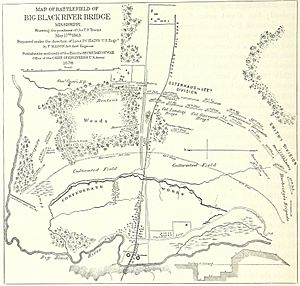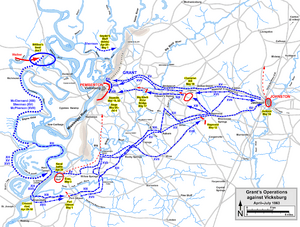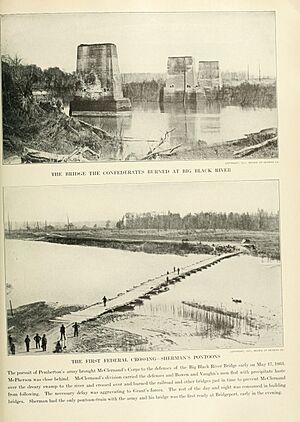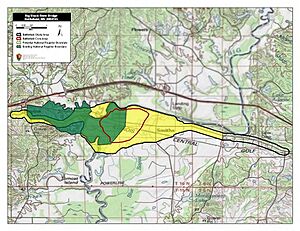Battle of Big Black River Bridge facts for kids
Quick facts for kids Battle of Big Black River Bridge |
|||||||
|---|---|---|---|---|---|---|---|
| Part of the American Civil War | |||||||
 A map of the battle |
|||||||
|
|||||||
| Belligerents | |||||||
| Commanders and leaders | |||||||
| Units involved | |||||||
| Strength | |||||||
| 2,500 | 5,000 | ||||||
| Casualties and losses | |||||||
| 276 | 1,751 | ||||||
The Battle of Big Black River Bridge was a quick but important fight during the American Civil War. It happened on May 17, 1863, as part of the Vicksburg Campaign. Just one day before, on May 16, the Union army, led by Ulysses S. Grant, had beaten the Confederate army at the Battle of Champion Hill.
After that loss, Confederate General John C. Pemberton needed time for his army to get away safely. He ordered General John S. Bowen to set up a "rear guard" at the Big Black River crossing. A rear guard is a small group of soldiers who stay behind to protect the main army as it retreats.
Union troops, led by General John McClernand, quickly caught up with Bowen's rear guard. The Union soldiers charged, and the Confederate position broke apart very fast. Many Confederate soldiers were captured, and 18 cannons were taken by the Union army. As the Confederates ran away, they burned both the railroad bridge and a steamboat that was being used as a bridge. The remaining Confederate soldiers went into the strong defenses of Vicksburg, Mississippi. The important siege of Vicksburg began the very next day.
Why Was This Battle Fought?
In March 1863, Union General Ulysses S. Grant was planning a big attack. His target was Vicksburg, Mississippi, a city that was very important for controlling the Mississippi River. Grant looked at different ways to attack Vicksburg. He decided the best way was to attack from the south.
On April 29, the Union Navy tried to attack Confederate forts at Grand Gulf, Mississippi. When that didn't work, Union soldiers, led by General John McClernand, landed further down the river. This forced the Confederates to leave their forts at Grand Gulf.
On May 1, Confederate forces led by General John S. Bowen tried to stop the Union army at the Battle of Port Gibson. The Confederates were greatly outnumbered. Even though they fought hard for most of the day, the Union troops eventually pushed them back. General Bowen decided to retreat.
The fighting continued, and on May 16, the Battle of Champion Hill took place. Confederate General John C. Pemberton gathered most of his army to try and stop Grant's army from reaching Vicksburg. The Union attacks were strong and broke through the Confederate lines. General Bowen's division tried to fight back, but Union reinforcements arrived. This forced Bowen to retreat again, and the Union army won the battle.
What Happened During the Battle?
After losing at Champion Hill, General Pemberton needed to protect his retreating army. So, on the night of May 16, he set up a defensive line at the Big Black River. This "rear guard" was made up of about 5,000 Confederate soldiers. These included troops from Missouri and Tennessee. Some of these soldiers, especially those from General John C. Vaughn's brigade, were new and didn't have much experience. Also, General Bowen's soldiers had fought very hard at Champion Hill and were tired.
The Confederate line was supported by three artillery batteries (groups of cannons). There were two ways to cross the river: a railroad bridge and a steamboat that had been placed across the river to act as a temporary bridge.
On the morning of May 17, General McClernand's Union troops moved towards the Confederate position. General Eugene A. Carr's division led the attack. An artillery duel (a fight between cannons) started. After some planning, General Michael K. Lawler's brigade of Union soldiers charged forward.
Lawler's charge was incredibly fast, lasting only about three minutes. It quickly broke through the Confederate line. General Vaughn's inexperienced soldiers ran away in a panic. This created a big gap in the Confederate defenses, forcing other brigades to retreat as well. The retreat was very messy, with soldiers trying to save themselves.
The Confederates lost many cannons because their horses, which were needed to pull the cannons away, were on the other side of the river. In total, 18 Confederate cannons were captured by the Union army. The retreating Confederates then burned both the railroad bridge and the steamboat bridge. The soldiers who escaped joined the main Confederate army inside the strong defenses of Vicksburg.
Union Sergeant William Wesley Kendall was given the Medal of Honor for his bravery. He led a company in the main Union charge and was one of the first Union soldiers to enter the Confederate defenses.
What Happened After the Battle?
The Confederates suffered heavy losses at Big Black River Bridge. They lost 1,751 men, and almost all of them were captured as prisoners. The Union army had far fewer losses, with only 273 or 276 casualties.
After this battle, the important siege of Vicksburg began on May 18. General Grant tried a major attack on Vicksburg's defenses on May 22, but it was stopped. Later attempts to blow up parts of the Confederate lines also failed. However, the Confederates inside Vicksburg were running out of food and had no hope of getting help. Because of this, General Pemberton surrendered the city and his soldiers on July 4.
Today, you can still see parts of the old railroad bridge piers from the battle at the Big Black River. There's a trail along the river and a historical marker nearby. Some of the battlefield land has been protected by the Civil War Trust.





